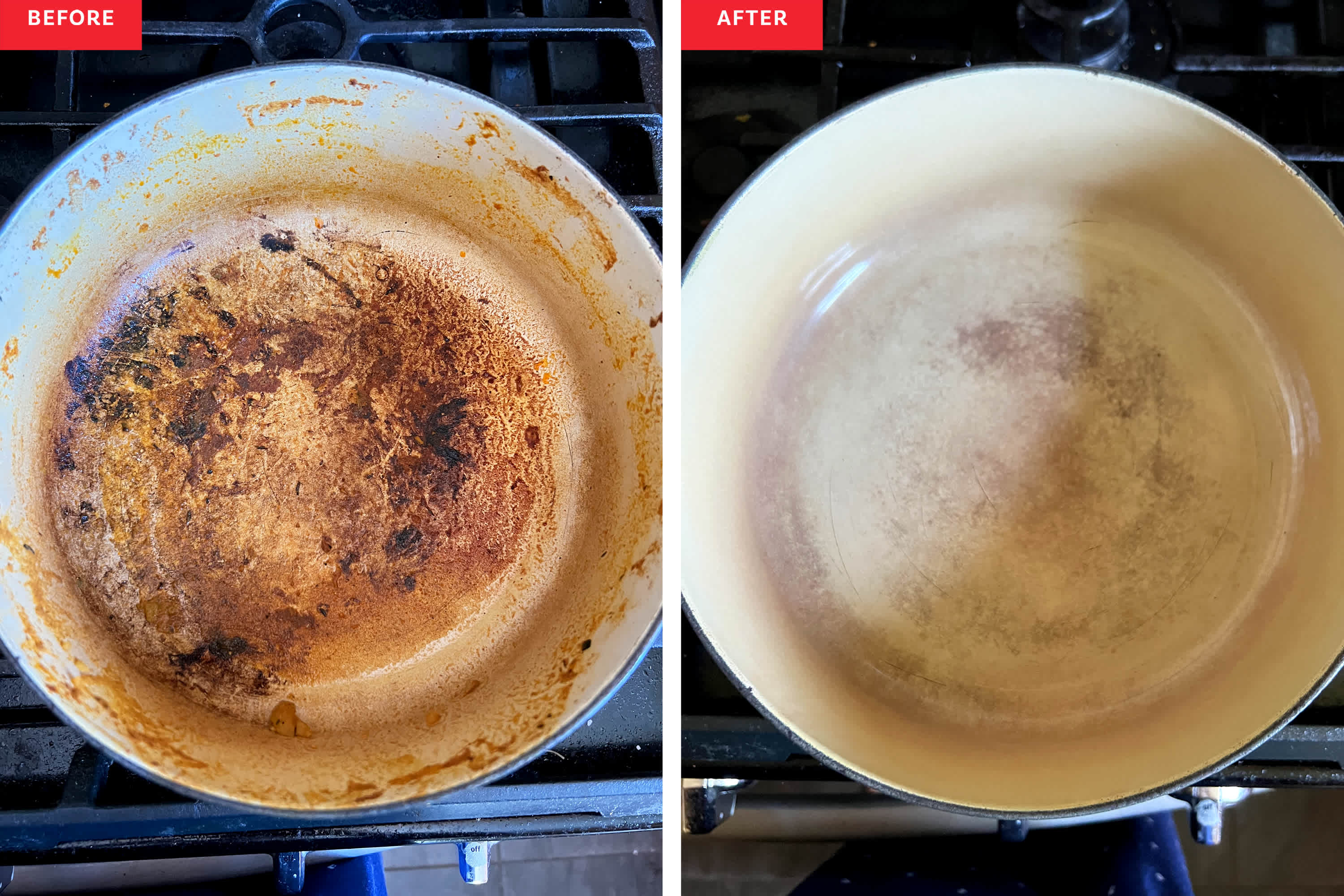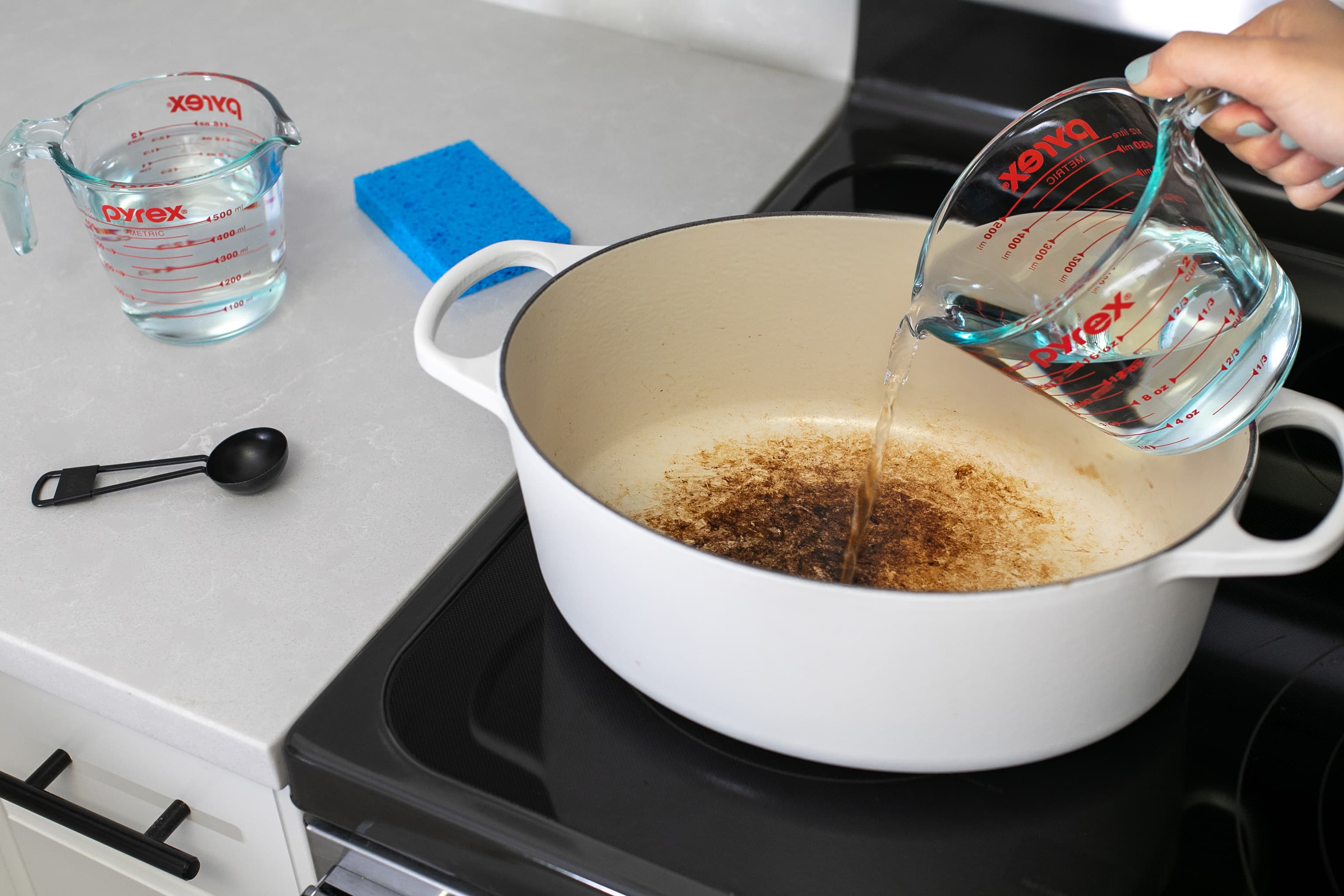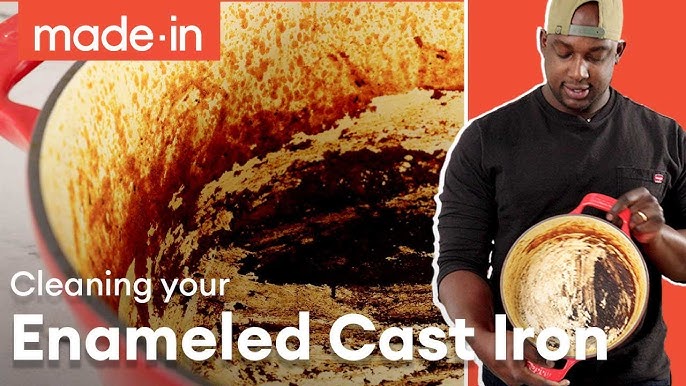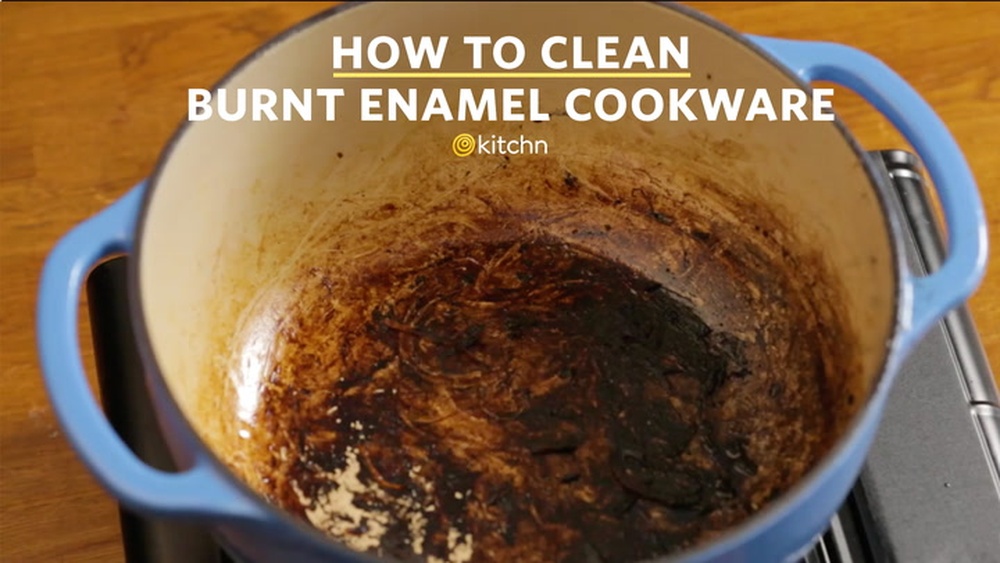You’ve just finished cooking a delicious meal in your enamel Dutch oven, only to find stubborn burnt-on stains staring back at you. It’s frustrating, isn’t it?
You want your beautiful pot to look as good as new, but scrubbing hard risks damaging the enamel surface. Don’t worry—cleaning a burnt Dutch oven doesn’t have to be a nightmare. With a few simple, safe techniques, you can restore your pot’s shine without the hassle or harsh chemicals.
Keep reading, and you’ll learn easy, effective methods to tackle those tough burnt spots and keep your Dutch oven in perfect condition for many meals to come.
Removing Fresh Burnt Residue
Removing fresh burnt residue from your enamel Dutch oven is a simple task. Acting quickly prevents stubborn stains and damage. The key is gentle cleaning methods that protect the enamel surface. Start with soaking and then use a wooden spoon for careful scraping. These steps loosen burnt bits without scratching.
Soaking With Warm Soapy Water
Fill the Dutch oven with warm water and a few drops of dish soap. Let it soak for at least 30 minutes. The warm, soapy water softens the burnt residue, making it easier to remove. Avoid using boiling water as sudden temperature changes may harm the enamel.
After soaking, the burnt bits will loosen. This step reduces the effort needed for cleaning. It also helps prevent scrubbing too hard, which can scratch the surface.
Using Wooden Spoon For Scraping
Use a wooden spoon to gently scrape the softened burnt residue. Avoid metal utensils that can damage the enamel. Wooden spoons are firm but safe for the surface.
Scrape carefully in small sections. Do not press too hard. Remove as much burnt material as possible without causing scratches.
Once most residue is off, wash the Dutch oven with warm, soapy water. Rinse and dry thoroughly to keep your enamel Dutch oven looking new.
Baking Soda Cleaning Methods
Baking soda is a gentle and effective cleaner for burnt enamel Dutch ovens. It helps remove tough stains without damaging the surface. Using baking soda cleaning methods is simple and safe. These methods soften burnt food and lift stains for easy cleaning.
Boiling Baking Soda Solution
Fill your Dutch oven with enough water to cover the burnt areas. Add two to three tablespoons of baking soda. The mixture will bubble and foam.
Bring the water to a boil on medium heat. Let it simmer for 15 to 20 minutes. The heat and baking soda work together to loosen burnt bits.
Turn off the heat and allow the pot to cool. Use a wooden spoon to gently scrape away the softened residue. Pour out the water and wash the pot with dish soap and a soft sponge. Rinse and dry thoroughly.
Applying Baking Soda Paste
Mix baking soda with a few drops of warm water to form a thick paste. Apply the paste directly on burnt or stained spots inside the Dutch oven.
Let the paste sit for several hours or overnight. This gives baking soda time to break down the burnt food and stains.
Scrub the paste gently with a nylon brush or a non-abrasive sponge. Avoid harsh scrubbing to protect the enamel surface. Rinse the pot with hot, soapy water and dry completely before storing.
Tackling Stubborn Stains
Burnt stains on an enamel Dutch oven can be tough to remove. These marks often look opaque and stubborn. Cleaning them requires patience and the right methods. Using harsh tools or chemicals may damage the enamel surface.
Gentle but effective approaches work best to restore your Dutch oven’s shine. Two reliable techniques are soaking with bleach and scrubbing with a nylon brush. Both help lift deep stains without harming the enamel.
Bleach Soak For Opaque Marks
Prepare a solution by mixing three parts water with one part bleach. Pour this mixture into your Dutch oven, covering the burnt areas completely. Let it soak for several hours or overnight for heavy stains.
After soaking, empty the solution carefully. Wash the pot with warm soap and water. Rinse thoroughly to remove all bleach residues. This soak helps break down tough, opaque stains safely.
Scrubbing With Nylon Brush
Use a nylon brush to scrub the stained areas gently. Avoid metal scrubbers that can scratch the enamel surface. Apply light pressure and move in circular motions to lift the burnt bits.
For better results, combine scrubbing with a paste of baking soda and water. This paste acts as a mild abrasive that cleans without damage. Rinse the Dutch oven well and dry it completely after scrubbing.

Credit: www.thekitchn.com
Tools To Avoid
Cleaning a burnt enamel Dutch oven requires care. Choosing the right tools is crucial to avoid damage. Some common cleaning tools may harm the enamel coating. Using the wrong tools can lead to scratches or dullness. Here are the tools you should avoid to keep your Dutch oven safe and shiny.
Why Not Use Steel Wool
Steel wool is very rough on enamel surfaces. It can scratch the smooth coating easily. These scratches allow stains and rust to form. Once scratched, the enamel loses its protective qualities. The rough texture removes the finish, making cleaning harder next time. Avoid steel wool to keep your Dutch oven looking new.
Risks Of Abrasive Scrubbers
Abrasive scrubbers, like metal scouring pads, also damage enamel. They wear down the glossy finish over time. This wear can cause chips and cracks. Cracked enamel lets moisture reach the metal underneath. This moisture causes rust and weakens the pot. Use gentle sponges or brushes instead of abrasive scrubbers to protect your Dutch oven.
Drying And Storage Tips
Proper drying and storage keep your enamel Dutch oven in top shape. After cleaning, focus on removing all moisture. This step prevents damage and extends the life of your pot.
Ensuring Complete Dryness
Use a clean towel to dry your Dutch oven thoroughly. Wipe every part, including the lid and rim. Air dry the pot upside down on a drying rack. This method allows any leftover moisture to evaporate. Avoid storing the pot while damp. Moisture can cause spots and weaken the enamel over time.
Preventing Rust And Damage
Store the Dutch oven in a cool, dry place. Avoid stacking heavy items on top to prevent chips and cracks. Place a paper towel or cloth between the lid and pot. This step improves air circulation and stops moisture buildup. Check your pot regularly for signs of rust or damage. Early care helps maintain its beauty and function for years.

Credit: www.thekitchn.com
Maintenance For Longevity
Proper maintenance extends the life of an enamel Dutch oven. Careful cleaning and handling keep it looking new. Avoiding burnt build-up prevents damage and makes cleaning easier. Follow simple daily habits to protect the enamel surface and maintain performance.
Regular Cleaning Habits
Clean your Dutch oven after every use. Use warm water and mild dish soap. Avoid harsh cleaners or metal scrubbers. These can scratch or chip the enamel. Use a soft sponge or cloth for washing. Rinse well to remove soap residue. Dry completely before storing to prevent rust. Wipe the edges and lid seals gently. Regular care stops stains and burnt marks from forming.
Preventing Burnt Build-up
Use low to medium heat for cooking. High heat can cause food to stick and burn. Always add oil or liquid before heating. Stir food often to prevent sticking. Avoid cooking acidic foods for long periods. Acid can damage the enamel over time. When food sticks, soak the pot with warm water and baking soda. This softens burnt bits, making them easier to clean. Following these tips reduces burnt build-up and keeps your Dutch oven in top shape.

Credit: www.youtube.com
Frequently Asked Questions
How To Get Burn Marks Off Enamel In A Dutch Oven?
Fill the Dutch oven with water and baking soda. Simmer, then scrape burnt bits gently with a wooden spoon. Wash with soap and sponge. For tough stains, apply a baking soda paste, let sit, scrub softly, rinse, and dry thoroughly.
Avoid abrasive tools to protect the enamel.
How Do You Get The Brown Stuff Out Of A Dutch Oven?
Fill the Dutch oven with water and add baking soda. Simmer for 15 minutes. Scrape loosened residue with a wooden spoon. Wash with dish soap and a soft sponge. For tough stains, apply a baking soda paste, let sit, then scrub gently.
Rinse and dry thoroughly.
How To Restore An Enameled Dutch Oven?
Fill the Dutch oven with warm water and baking soda. Simmer for 15 minutes, then scrub gently with a soft sponge. For tough stains, apply a baking soda paste and let it sit before scrubbing. Rinse thoroughly and dry completely to restore the enamel finish.
How Do You Clean A Badly Burnt Oven?
Fill the oven with water and baking soda, then simmer for 15 minutes. Scrape burnt bits with a wooden spoon. Let cool, drain, and wash with dish soap and a soft sponge. Repeat if needed to remove stubborn stains. Avoid abrasive tools to protect enamel.
Conclusion
Cleaning a burnt enamel Dutch oven does not have to be hard. Use baking soda and water for gentle, effective cleaning. Avoid harsh scrubbing tools to protect the enamel surface. Patience helps; let cleaning pastes sit before scrubbing. Regular care keeps your Dutch oven looking great.
With simple steps, you can restore your pot without damage. Enjoy cooking again with a clean, well-maintained Dutch oven.

